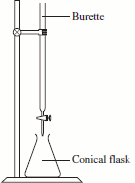Determining the Concentration of Acetic Acid in Vinegar by Direct Titration
Key Concepts
- Vinegar is produced by the oxidation of ethanol.
- Table vinegar typically contains between 4 and 8 % v/v acetic acid (ethanoic acid).
- Acetic acid is a weak, monoprotic, organic Brønsted-Lowry acid:
acetic acid
(ethanoic acid)acetate ion
(ethanoate ion)H
|O
||H- C - C -O-H |
H
H+ + H
|O
||H- C - C -O- |
Hacid conjugate base - Acetic acid (ethanoic acid) will react with a strong base in neutralisation reaction:
acid + base → water + salt H
|O
||H- C - C -O-H |
H+ NaOH(aq) 
H-OH(l) + H
|O
||H- C - C -O-Na+ |
Hacetic acid
(ethanoic acid)+ sodium hydroxide → water + sodium acetate
( sodium ethanoate) - It is therefore possible to determine the concentration of acetic acid in vinegar by titrating the vinegar with a strong base such as aqueous sodium hydroxide solution.
moles of acetic acid
in vinegar sample= moles of sodium hydroxide
used in titrationn(CH3COOH) = n(NaOH) concentration
of acetic acid= moles of acetic acid
volume of vinegarc(CH3COOH) = n(CH3COOH)
V(vinegar)Using the known density of acetic acid it is possible to calculate the concentration of acetic acid in vinegar as a v/v%:
v/v % = volume of acetic acid
volume of vinegar× 100

